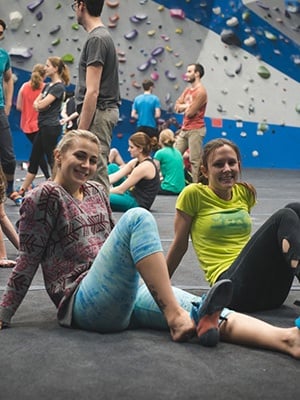The Sendy Times
Expand your climbing knowledge with training tips and tricks from Movement's instructors, trainers, and coaches.

We get a lot of questions about how to climb better and because we are so stoked to see you succeed, we’ve asked our trainers, coaches, and instructors at Movement locations all over the country to provide as much training, technique, and fitness advice to help you achieve your goals. But what is a good goal? Who are climbing goals for—are those only for those who’ve been climbing for a while? How do you make a good goal? In all parts of life goals can give us a clearer path toward the outcomes we desire. In climbing, goals can help you focus and approach your gym sessions with more intention. You’ll make the most of your time at the gym while on your way to crushing your objective, whether it’s to climb one route at a certain grade, feel comfortable climbing most routes at a certain grade, send a certain route, you get the idea. So instead of more general climbing tips and tricks, let’s take a step back and look into how to craft a climbing goal made specifically for you by you.

By: Tim Seale
Climbers regularly ask us for advice on how to climb better and harder. Of course, there are a jillion ways to answer that question--endurance training, training board exercises, etc. For the sake of this article, we're focusing on small shifts in your climbing technique that will help you save big energy while climbing.

Get the latest climbing news, tips and tricks straight to your inbox.

By: Conor
Ok, today we’re talking about climbing with straight arms versus climbing with bent arms. If you find yourself moving up the wall by grabbing a hold and using your arms to pull it down to you all the way up the wall, we have news for you! There is a much less tiring way to climb! Let’s learn how to climb with straight arms.

Training for Climbing | Climbing Tips
By: Kim
Do you practice failing? Probably not. Let’s be honest – failure is hard for a lot of us, especially if you’ve been conditioned to think of failure as a bad thing.

By: Sydney King
“What’s the big deal with yoga for climbers? Can’t I just climb more to get better?” We hear this a lot, and we get it—if you love climbing, it makes sense that the one way to get better is to practice it regularly. A lot of articles around the internet will tell you how and why yoga is important. We wanted to show you how adding a regular yoga routine to your schedule (find your gym and check out their upcoming class calendar) will give you the balance, strength, and coordination you’ll need to make snagging your next climbing goal a little easier.

Training for Climbing | Fitness and Yoga
By: Dan Umbreit
If you’re guilty of climbing one “easy” route, jumping on your project once or twice and then heading home, this blog is for you. Warming up gets the blood flowing and raises your body's temperature. It's critical to preventing injury, increasing mental focus, and getting the body primed for producing force to try hard. Conversely, what you do AFTER climbing can be just as important as your warm-up before. An effective cool-down routine releases the muscles, slows your breath, and jumpstarts the recovery process.

Training for Climbing | Fitness and Yoga
By: Aaron Neal
A pistol squat is an exercise that is very easy to explain, but hard for most people to do. From a standing position, shift your weight to one leg while the other leg shoots forward. From there, you squat down, bringing your tailbone to your heel and then stand up from a seated or squat position, again only using one leg. Pistol squats are great for increasing leg strength and improving balance, which means they really give you a leg up in your climbing.

By: Movement
One of the things our instructors, trainers, and coaches love the most is sharing tips and advice with stoked climbers to help them progress and reach their climbing goals. But as with most things, some of us occasionally find ourselves feeling a bit drained from climbing and training. Well, you aren't alone! Know that lots of climbers have periods where they're less motivated or psyched to hit the gym (a quick google search will further confirm this if you weren't sure). We reached out to Marisa Romero, Director of Youth Teams, and asked her how our instructors and coaches help Movement's Team kids when they lose their climbing motivation. She had great advice to help you get back to being stoked!

By: Taylor Slay
We've talked in previous blogs about the importance of maintaining a strong core when climbing. As a reminder, a strong core allows you to keep body tension on the wall, helps you keep your feet on the wall, and it generally just helps you move more powerfully and efficiently.

Training for Climbing | Fitness and Yoga
Climbing requires a lot of overhead shoulder and arm movement and can put quite a bit of stress on the shoulders. All of this strain can lead to injuries ranging from minor muscle tweaks to major tendon tears. The good news is there are a few very effective exercises that strengthen the shoulder and prevent injuries.